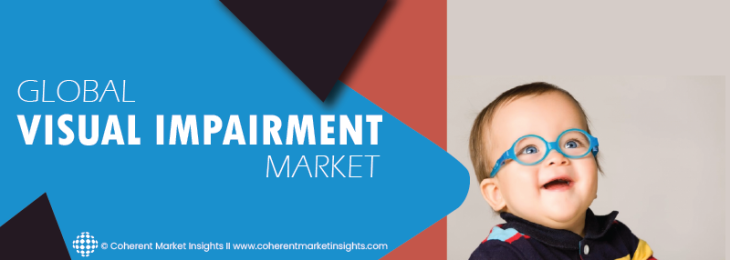
Over the forecast period, rising rates of vision impairment and blindness and rising rates of eye illnesses are anticipated to propel market expansion. For instance, according to the World Health Organisation (WHO), at least 1 billion individuals worldwide suffered from near- or farsightedness in 2019. In addition, it is anticipated that there will be an increase in the number of visually impaired people worldwide as a result of eye disorders like age-related macular degeneration, refractive error, glaucoma, cataracts, and diabetic retinopathy becoming more common. The market for visual impairments will subsequently rise as a result. For instance, according to the World Glaucoma Association, 79.6 million people would have glaucoma worldwide in 2020. In 2040, this figure is projected to rise to 111.8 million people. The development of the global market for visual impairment is also anticipated to be fueled by rising government initiatives to support assistive technology and offer assistive technology products to the impaired. Governments are placing a priority on funding NGOs that are creating assistive technologies for the disabled.
As per Coherent Market Insights, over the projected period (2020-2027), the market for Visual Impairment is anticipated to grow at a CAGR of 8.1%, reaching an estimated value of US$ 4,362.8 million in 2020.
Prominent Companies in the Visual Impairment Industry:
1. Adaptivation, Inc.
The company was started in 1992 and is based in Sioux Falls, South Dakota, United States. The business sells wearable technology, lamps, optical magnifiers, and lamps along with desktop and handheld video magnifiers. A manufacturer of switches, environmental controls, and other helpful equipment for people, Adaptivation makes electronic communication assistance.
2. AbleNet, Inc.
The company was started in 1985 and is located in Saint Paul, Minnesota, United States. Products for children and people with impairments are offered by AbleNet Inc. The business produces special education classroom materials and software, access aids for all ages and circumstances, and communication assistance for nonverbal people.
3. Amedia Corporation
The business was founded in 1948 and is based in Oslo, Norway. Production of motion pictures for theatrical and nontheatrical distribution as well as videotapes is part of the company's line of business. Amedia stated in April 2022 that it would give Dmitry Muratov, the editor-in-chief of the daily Novaya Gazeta, four printing facilities in Russia valued approximately 4 million euros.
4. Access Ingenuity
The firm was started in 2002 and is based in Santa Rosa, California, United States. Digital accessibility services are offered by Access Ingenuity LLC. The business provides training, testing, and accessibility reviews for mobile apps and websites. Training is offered by Access Ingenuity to businesses and end consumers.
5. American Thermoform
The firm was started in 1962 and is located in California. In terms of manufacturing and distributing goods and supplies for the blind and visually impaired, American Thermoform is a global leader. The company's commercial activities include printing trades and machinery production.
6. Cambium Learning
The business was founded in 2009 and is based in Dallas, Texas, United States. The business offers products and services for education. The business provides tools for learning intervention, educational resources, and services for implementation. Cambium acquired Rosetta stone in September 2020 in an all-cash transaction with an equity worth of roughly $792 million.
7. HumanWare Group
The firm was started in 1988 and is based in Drummondville, Canada. HumanWare is an expert in the design and production of incredibly clever and intuitive solutions for those with vision loss or other visual impairments. HumanWare creates and sells cutting-edge, high-tech solutions that cater to the demands of our blind and low-vision clients all over the world.
Definition: Visual impairment can refer to any form of vision loss, including partial vision loss or the inability to see at all. Cataracts, amblyopia, diabetic retinopathy, glaucoma, macular degeneration, and other disorders can all result in visual loss after birth.










